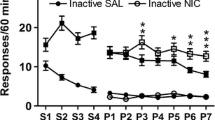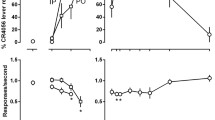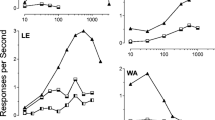Abstract
Interactions between the discriminative and reinforcing effects of midazolam were studied in two baboons trained to discriminate midazolam (0.32 mg/kg, IV) from saline. The midazolam generalization gradient determined after the baboons were permitted to self-administer midazolam (IV) was shifted to the left of that determined before self-administration. In contrast, the midazolam generalization gradient determined after the same doses of midazolam were delivered response-independently, but in the same order and with the same temporal pattern as during self-administration, was shifted to the right of that determined just before the response-independent phase. These data suggest that sensitivity to the discriminative-stimulus effects of a drug can be modulated by behavioral experience with that drug.
Similar content being viewed by others
References
Barrett JE, Glowa JR, Nader MA (1989) Behavioral and pharmacological history as determinants of tolerance- and sensitization-like phenomena in drug action. In: Goudie AJ, Emmett-Oglesby MW (eds) Psychoactive drugs: tolerance and sensitization. Humana Press, Clifton, New Jersey, pp 181–219
De Wit H, Stewart J (1981) Reinstatement of cocaine-reinforced responding in the rat. Psychopharmacology 75:134
Dworkin SI, Porrino LJ, Smith JE (1992) Importance of behavioral controls in the analysis of on-going events. In: Brown R, Frascella J (eds) Neurobiological approaches to brain behavior interaction. NIDA Research Monograph. Alcohol Drug Abuse and Mental Health Administration, Washington, DC (in press)
Griffiths RR, Lukas SE, Bradford LD, Brady JV, Snell JD (1981) Self-injection of barbiturates and benzodiazepines in baboons. Psychopharmacology 75:101–109
Griffiths RR, Sannerud CA, Ator NA, Brady JV (1992) Zolpidem behavioral pharmacology in baboons: self-injection, discrimination, tolerance and withdrawal. J Pharmacol Exp Ther 260:1199–1208
Heizmann P, Eckert M, Zeigler WH (1983) Pharmacokinetics and bioavailability of midazolam in man. Br J Clin Pharmacol 16:43S-49S
Sannerud CA, Cook JM, Griffiths RR (1989) Behavioral differentiation of benzodiazepine ligands after repeated administration in baboons. Eur J Pharmacol 167:333–343
Spealman RD (1985a) Discriminative-stimulus effects of midazolam in squirrel monkeys: comparison with other drugs and antagonism by Ro 15-1788. J Pharmacol Exp Ther 235:456–462
Spealman RD (1985b) Environmental factors determining the control of behavior by drugs. In: Seiden LS, Balster RL (eds) Behavioral pharmacology: the current status. Liss, New York, pp 23–38
Steiner SS, Beer B, Shaffer MM (1969) Escape from self-produced rates of brain stimulation. Science 163:91
Young AM, Sannerud CA (1989) Tolerance to drug discriminative stimuli. In: Goudie AJ, Emmett-Oglesby MW (eds) Psychoactive drugs: tolerance and sensitization. Humana Press, Clifton, New Jersey, pp 221–278
Author information
Authors and Affiliations
Rights and permissions
About this article
Cite this article
Ator, N.A., Griffiths, R.R. Differential sensitivity to midazolam discriminative-stimulus effects following self-administered versus response-independent midazolam. Psychopharmacology 110, 1–4 (1993). https://doi.org/10.1007/BF02246943
Received:
Revised:
Issue Date:
DOI: https://doi.org/10.1007/BF02246943




